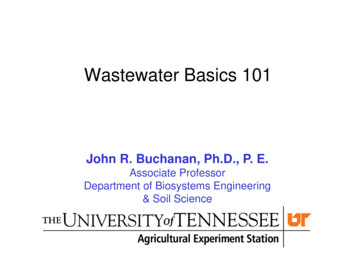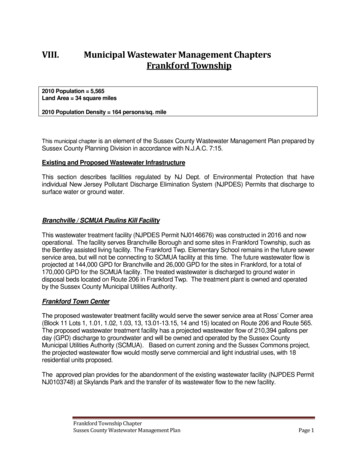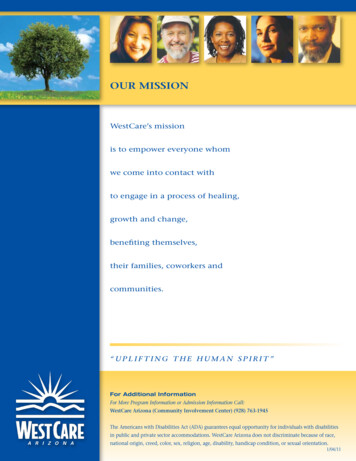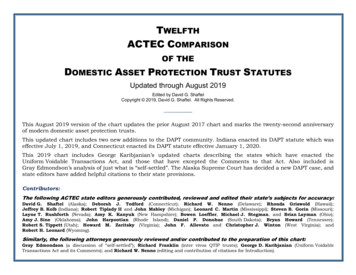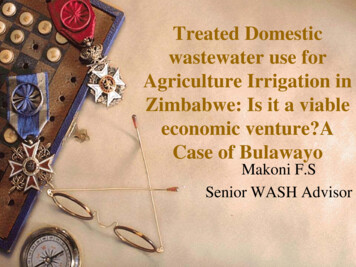
Transcription
Treated Domesticwastewater use forAgriculture Irrigation inZimbabwe: Is it a viableeconomic venture?ACase of BulawayoMakoni F.SSenior WASH Advisor
Presentation outline Introduction Policy and By-Laws in Zimbabwe on wastewater use( S.I.274 of 2000: Waste & effluent disposal) Study area and background Findings Social acceptance Implication on Public and environmental Health Economic benefits Proposed management model
Introduction Urban wastewater use in agriculture isbecoming more common and widespreadpractice due to the increasing watershortage and the threat to food securityespecially among the urban resourcelimited farmers
Introduction cont. Wastewater is an important resource forurban irrigation (water scarcity) Reduced productivity in rural areas most urban utilities generate a lot ofwastewater from their treatments plantswhich they have problems in managing
Policy and By- Laws Obstacles to wastewater use are real but notinsurmountable. WHO/ZINWA published guidelines for the safeuse of wastewater and excreta in agriculture andaquaculture to protect the public. Environmental Management Act (Chapter 20:27) S.I. 247 of 2000, Water, ( Waste and effluentdisposal) Waste & solid waste disposal Regulation S.I 6 of2007 Municipal By- Laws ( Bulawayo City)
Background to study The City of Bulawayo- (1894) is thesecond largest city. Matabeleland province, a semi arid anddrought prone region. Was a centre of commercial and industrialactivities. The City of Bulawayo in 1991/92 survivedthrough the severest drought in 'LivingMemory'.
Why wastewater use inBulawayo The need for a reliable agricultural water supplyis therefore critical. –watershed effect Options such as use of effluent from treatmentplants for agriculture is one feasible wayBulawayo City Council-MAS type Future trends, quantity and quality considerations( Water demand Management).
Why this study Uncontrolled use of wastewater forproduction of crops by residents hence theneed to: Improve and inform safe and sustainablelong term production of crops that complywith existing standards ( heavy metals) Protection of users and consumers(balancing public & environmental health)
Study area The study area is Luveve Gum Plantationarea in Bulawayo, the second largest cityof Zimbabwe. drought prone, semiarid Matebelelandregion of Zimbabwe. an average rainfall of 460mm per annumand a population of 1 million.
Study area The effluent comes from two treatmentplants and these are the Pumula and theLuveve plants, which converge, anddischarge into 375mm pipe and deliverseffluent into an earth made tank at the farm 4.5Mm3 -5Mm3/day Sandy soils are the prominent soils in thefarming area
Study area The farming area is about 350 acres with atotal of 1100 farmers who were chosen onsocial backgrounds from most of theBulawayo high residential locations. Eachfarmer has about 100m X 5m plot tocultivate
Study site
Objectives To determine the physical and biologicalcharacteristics of the treated domestic effluentused for urban agriculture irrigation in Bulawayo. To assess the levels of lead (Pb) and cadmium(Cd) in soils and crops under irrigation withtreated domestic wastewater effluent inBulawayo.
Objectives Assess the suitability of the effluent used incomparison to existing guidelines and standardsfor urban agriculture irrigation. To quantify potential socio-economic benefits ofwastewater use in small scale urban agricultureirrigation in Bulawayo. To propose a management strategy forsustainable utilisation of treated domesticwastewater for irrigated agriculture in Bulawayo.
Starting off Baselines MPAP ( Multi Actor Action Planning andPolicy making Process.
Findings Social acceptance: different perceptions regarding waste withsome expressing deep disgust and othersexpressing practical preferences However, the ultimate behaviour is partlydetermined by survival economics Majority not comfortable in usingwastewater products- due to misinformation.
Findings Chemical parameters: Nitrogen in the effluent wastewater wasfound to be in the range of 7mg/l to 13mg/lwith mean nitrogen concentration of11.5mg/l 4.4. A Variation of total phosphorusconcentration in the effluent was observedand a mean of 13.5mg/l 14.9
Findings Cadmium concentration in the effluent wasmeasured and a mean concentration of0.027mg/l 0.01 was observed Total mean Lead in the effluent was foundto be 0.45 mg/l and the concentration ofeffluent ranged from 0.2 to 0.91mg/l with astandard deviation of 0.186
0.06Conc. mg/l0.050.04Average Cd Conc.STC0.03LTC0.020.010.00123Samples sites45
0.70.60.5mg/lAverage Pb Conc.0.40.30.20.10123sample sites45
Findings The mean faecal coliform 5836 cfu/100mland 7291 cfu /100ml that was observed isabove both the WHO and nationalrecommended standards for irrigation
Findings The soil pH ranged from 6.69 to 7.83 pHunits for the field and 6.93 to 8.1 pH unitsfor the control depths. The average pHwas 7.35, 7.33, 7.72 and 7, 35 pH units forthe 0-10cm, 10- 20cm, 20-30cm field and7.35 control respectively.
Findings The total nitrogen concentrations of thesoil were generally low. The field soilnitrogen for all depths ranged from 26.31to 32.21 mg/kg where as for the control itranged from 22.41 to 26 mg/kg.
Findings The average phosphorus value in the soilwas 114 mg/kg for the 10cm in the fieldand 124.9 mg/kg for all depths in the field
Findings The average cadmium value was found tobe 0.95mg/kg in the field for all depths
1.021.00y 0.128x 2E-132R 1Soil Cd0.980.96Soil CdPredicted Soil CdLinear (Predicted Soil ed soil pH7.607.657.707.75
Heavy metals in crops Heavy metals were determined in theedible parts of the selected crops namelyChomolia, maize (zea mays) and beans(Vicia faba) which are mostly grown in thearea
Heavy metal (mg/kg)CropCdPbChomolia (leaf)--Beans (fruit)--Maize (seed)--Recommended safety standards0.050.4
Economic benefits Applying the conventional market basedapproach to calculate the monetary incomeeach plot holder was estimated to earn US 20 per month from vegetables, US 50from sugar beans and US250 from greenmealies. This looks at the current cost ofcommodities in the market and use itcalculate the monetary value
Economic benefits Estimated annual income from each plotwas calculated to be US 540. as a conservative figure
Economic benefits: fertilisercontr Nitrogen: 92kg/ha/year Phosphorous: 108Kg/ha/year Potassium: 281.6 Kg/ha/year.
Challenges Quality of wastewater Availability Legality Land tenure
Consideration for proposed use. quality classes in order to guide the user tothe potential advantages as well asproblems associated with its use and toachieve optimum crop production. The water quality classifications are onlyindicative guidelines and their applicationwill have to be adjusted to conditions thatprevail in the field.
So how can we go forward By engaging into urban agriculture through theuse of wastewater. Consider the following Crop rotations Restricted and unrestricted Cereals the first options Maize- Wheat- Sorghum Soyabeans Pastures for beef cattle.
Getting started Policies Financing the venture (contactfarming)Vegatables Technical assessments- land availability,soil types and types of crops, wastewaterquality
Implementation A management company ( the driver) withoptions of partnerships arrangements
conclusion Would you eat cropsgrown usingwastewater. THANK YOU
shortage and the threat to food security especially among the urban resource limited farmers . . the ultimate behaviour is partly determined by survival economics . quality classes in order to guide
